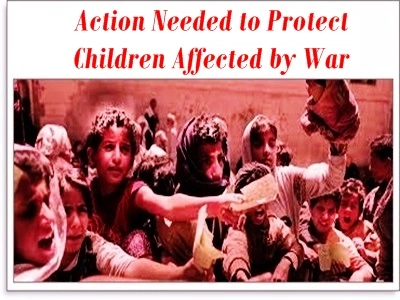War and conflict have devastating effects on all aspects of society, but the most vulnerable group that suffers immensely is children. The innocent lives of these children are disrupted, their physical and mental health is jeopardized, and their futures are robbed from them. In this blog post, we will explore the urgent action needed to protect children affected by war. By highlighting the challenges they face and proposing solutions, we can work towards creating a safer and more secure environment for these children.
Section 1: Understanding the Impact of War on Children
The horrors of war leave a profound impact on children, both physically and emotionally. They become victims of violence, forced displacement, separation from families, recruitment as child soldiers, sexual exploitation, malnutrition, lack of education opportunities, and trauma-induced mental health issues. It is crucial to raise awareness about the harsh realities they endure.
Section 2: International Legal Framework for Child Protection
To address the plight of children affected by war globally, multiple international legal frameworks have been established. The Convention on the Rights of the Child (CRC) adopted by the United Nations provides a comprehensive set of rights that should be universally granted to every child. It includes protection from armed conflicts and emphasizes the need for rehabilitation programs and reintegration into society.
Section 3: Strengthening National Policies
While international legal frameworks play a significant role in protecting children affected by war, national governments must also prioritize their well-being through robust policies. This includes measures such as enacting laws against child recruitment or exploitation in armed forces and providing access to quality healthcare services and education.
Section 4: Investing in Psychosocial Support Services
Children grappling with the trauma of war require specialized psychosocial support services. These services aim to help them heal emotionally and psychologically through counseling sessions, group therapy, and creative outlets such as art and play therapy. Allocating resources towards these programs is essential to rebuilding their shattered lives.
Section 5: Rehabilitation and Reintegration Programs
Children who have been forcibly recruited or involved in armed conflicts need rehabilitation and reintegration support to overcome the horrors they have experienced. These programs should focus on providing education, vocational training, and psychosocial support to ensure their successful transition into society. Collaborative efforts between governments, NGOs, and international organizations are crucial for the effectiveness of these programs.
Section 6: Addressing Child Recruitment
One of the most pressing issues regarding children affected by war is their recruitment as child soldiers. Efforts must be made at both national and international levels to prevent this heinous practice. This includes stricter enforcement of laws against child recruitment, disarmament campaigns, and promoting alternative methods for conflict resolution.
Section 7: Ensuring Accessible Education Opportunities
Education plays a vital role in protecting children affected by war from falling into a cycle of poverty and violence. Governments should prioritize the establishment of safe schools in conflict zones, provide teachers with specialized training in trauma-informed care, develop inclusive curricula that address the mental health needs of children, and ensure access to education for all displaced children.
Section 8: Tackling Sexual Exploitation and Abuse
War creates an environment ripe for sexual exploitation and abuse, leaving children vulnerable to trafficking, forced marriages, and other forms of sexual violence. To combat this issue effectively, it is essential to implement stringent measures that punish perpetrators while providing safe spaces for victims to report incidents without fear of retaliation.
Section 9: International Cooperation and Aid
The protection of children affected by war requires collective action from the global community. Increased funding from donor countries will help deliver humanitarian aid directly to those in need. Collaboration between NGOs, governments, international organizations such as UNICEF or Save the Children, and local communities is crucial for effective implementation and sustainability of child protection initiatives.
Section 10: Raising Awareness and Advocacy
It is our duty to raise awareness about the challenges faced by children affected by war. Through engaging storytelling, effective communication campaigns, and advocacy efforts, we can mobilize public support for the rights and well-being of these vulnerable children. Together, we can create a world where no child’s future is stolen by war.
Conclusion
The protection of children affected by war requires action on multiple fronts. From strengthening national policies to investing in psychosocial support services, rehabilitation programs, and education opportunities, every effort counts. By working collectively at global, national, and community levels, we can ensure that these innocent lives are protected from the horrors of conflict. Only then can we pave the way for a brighter future where all children have the opportunity to thrive despite the scars left by war.



